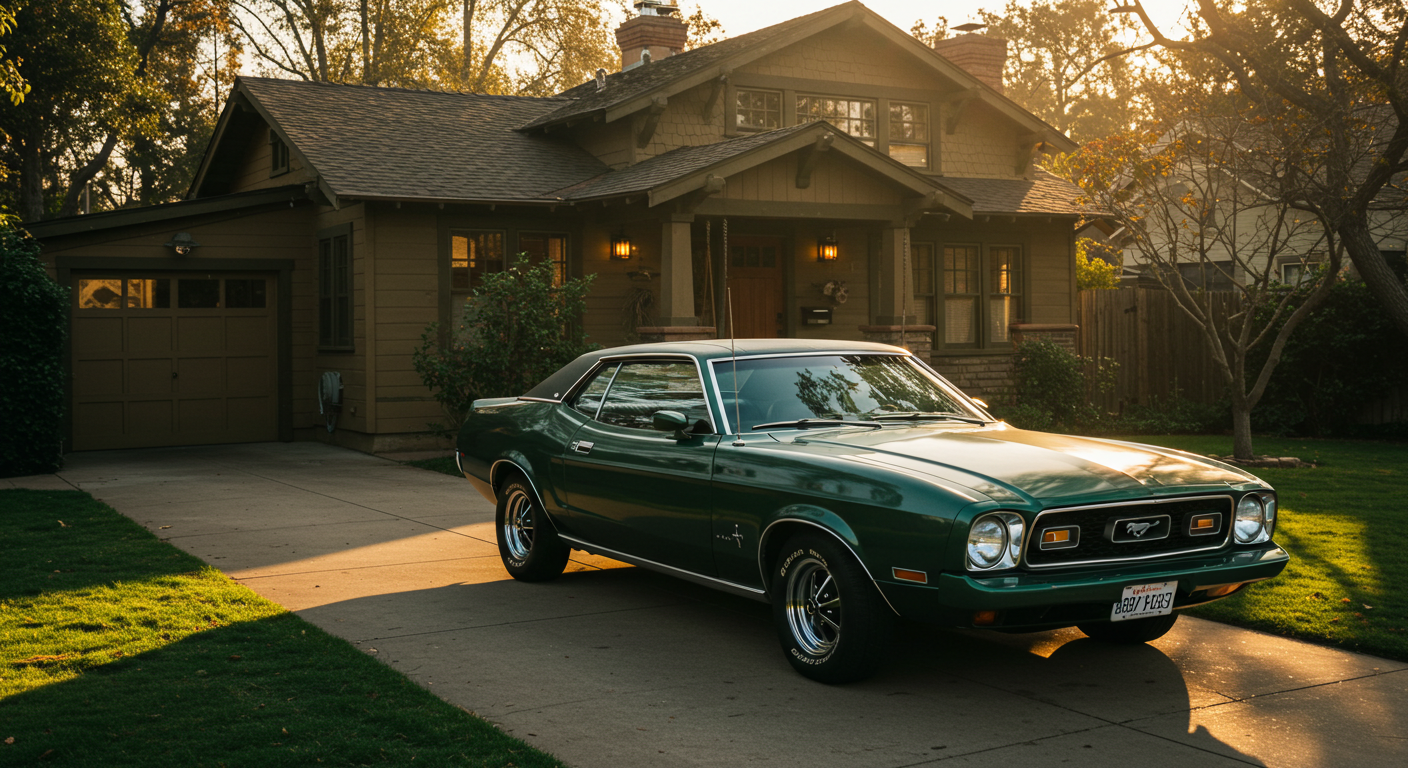The Mustang Curse: Why Every Few Years Ford Made One That Sucked
Author Bio: Danny is a co-owner of Driveway Dreams, an ASE Certified Master Technician with over 26 years of experience, and previous freelance writer for Car Engineer. For more than 17 years, he's owned and operated his own independent repair shop in Livonia, Michigan. Subscribe and follow, Danny!

Let me say this loud — Ford didn’t just make a few bad Mustangs. They built a cursed timeline of underachievers, screwups, and engine disasters that haunt garages, drag strips, and junkyards to this day.
Every few years, like a bad habit, Ford dropped a Mustang that looked the part but ran like hot garbage. Engines that ticked, pinged, cracked, overheated, burned oil, or wheezed their way through every green light. Sometimes it was emissions. Sometimes it was cost-cutting. Sometimes it was just sheer Detroit brain fog. But every time? It screwed over the driver.
This is the Mustang Curse. And I’ve lived through every chapter of it — wrench in hand, elbow-deep in oil and regret.
I’ve replaced timing chains, extracted snapped plugs, swapped in crate motors, chased phantom ticks, torched my fingers on overheated turbos, and counseled sobbing owners who just wanted their car to feel as fast as it looked. Every generation had at least one stinker. And for every killer 5.0 or Shelby GT500, there was some lump of iron trying its best to destroy the Mustang’s legacy from the inside out.
Here’s your full-throttle, uncensored tour through the decades of cursed engines and the once-proud Mustangs they doomed.
Buckle up, because the stupid doesn’t slow down.
Don't Buy a Cursed Mustang: Get My Insider Alert System
Join thousands of smart buyers who get my monthly reports on which Mustang years to hunt for and which to run from. I'll send you my exclusive "Mustang Red Flags" guide immediately.
1960s
The Mustang launched with a bang in 1964—but the base model's wheezy six-cylinder left muscle fans fuming. It promised performance, but delivered disappointment. The Mustang earned its icon status despite this weak start, not because of it.
The Inline-Six that Should’ve Stayed in a Falcon
Start at the beginning — the 1965 Mustang with a 170-cubic-inch inline-six.
It made just 101 horsepower. That’s lawnmower territory. And the base 3-speed transmission didn’t even bother with a synchronized first gear. Driving one felt like rowing a canoe through wet concrete. source
Ford wanted a low-cost entry-level Mustang. What they built was a sports car shell with a farm truck heart. It was slow, embarrassing, and couldn’t outrun a VW Beetle on a downhill. Most owners yanked the motor as soon as they could afford a 289 swap.
Even back then, enthusiasts knew what was up. The base model was just a bait-and-switch for broke buyers who wanted the look but not the performance.
Shop Story:
Guy brought in a ‘66 coupe — showroom clean. Said it couldn’t pass 60 on the highway without a tailwind. I popped the hood and felt like I was staring at a hair dryer with spark plugs. We swapped in a rebuilt 289 with a mild cam and dual exhaust. Next week? He smoked a Camaro at a red light and came back grinning like a kid who just stole Halloween.
Think that was sad? Just wait until the Mustang loses its soul completely — next stop: the Pinto years. You’re gonna want a seatbelt for this disaster.
1970s
The gas crisis and regulation era turned the Mustang into a neutered caricature of itself. Mustang II sales were strong, but the enthusiast trust? Torched. This decade diluted the brand’s muscle reputation and nearly killed the performance image altogether.
Mustang II — The Pinto in a Tuxedo
The 1970s Mustang II was the automotive version of your uncle wearing a tracksuit to Thanksgiving — a little flashy, a lot of disappointment.
2.3L Inline-4: 88 horsepower. Couldn’t outrun a milk truck. It looked like a Mustang, but moved like a lawn tractor. source
2.8L Cologne V6: Known for cam gear failure and suffocated heads. Oil starvation, plastic timing gears, and a sound like a popcorn machine at idle. source
302 V8: They brought back the V8… and neutered it. 122–139 horsepower. The only thing loud about it was the disappointment. source
This was Ford trying to survive the gas crisis, but instead of building something efficient and sharp, they gave us a Pinto chassis with Mustang badges. And it showed.
Shop Story:
Had a college kid limp in with a ‘77 Cobra II. 302 V8, or so he thought. I had to break the news it made less power than his mom’s Cutlass. Starter failed twice in one semester. Then the distributor gear shredded. I told him to ditch the whole motor. He eventually traded the car for a bicycle and a six-pack. Said the six-pack had more horsepower.
You thought that was bad? The ‘80s said, “Hold my beer,” and gave us turbo grenades and V8s that couldn’t outrun grandma’s Buick. Scroll on. It gets louder — and dumber.
1980s
The ‘80s brought fuel injection and turbo experimentation, but the execution flopped harder than an '84 cam phaser. Ford’s reputation in the performance community sagged as Mustangs sputtered off showroom floors. If power was the promise, reliability was the punchline.
Neutered V8s and Self-Cooking Turbos
Welcome to the ‘80s. Turbo dreams, smog nightmares, and disappointing dyno sheets.
255 Windsor V8 (4.2L): 115 hp. No, that’s not a typo. This engine was a downsized 302 that made your Mustang feel like it was dragging a boat anchor up a hill. source
2.3L Turbo I4: These little boosted motors were thrown into Cobra and Turbo GT trims. Cool on paper. Terrible execution. They overheated, cracked heads, detonated under boost, and cooked turbos like popcorn at a movie theater. source
Ford was experimenting with modern powertrains but didn’t seem to believe in testing them under heat or actual performance driving. The result? Underwhelming numbers and overcooked engines.
Shop Story:
An '84 Turbo GT came in blowing white smoke and chugging coolant like it was Gatorade. Head was cracked down the middle. We pulled the turbo — oil pooled in the inlet. The guy said it “ran fine last week.” I told him it probably boiled itself to death on the way to Taco Bell. He traded it in for a used Civic.
Next up? An engine so bad, it blew itself apart for fun — welcome to the ‘90s, where head gaskets had the lifespan of a mayfly. Keep reading. It’s about to boil over.
Join our private Mustang collector community
1990s
Ford tried to modernize the Mustang, but the 3.8L Essex V6 blew it—literally. Head gasket failures became a nationwide epidemic, damaging resale value and shaking consumer confidence. It was the era where Mustang owners became familiar with tow trucks.
Essex Engine — The Head Gasket Serial Killer
3.8L V6 (1994–2004): This engine is infamous. It loved to blow head gaskets. And not just once. I’ve seen some cars blow both sides twice before 80k. Sometimes even earlier. source
Some owners tried supercharging it to match GT numbers. Most ended up with warped heads and steam pouring out the tailpipe. It was the ‘90s Mustang for people who thought a Mustang should be slower than a Corolla.
Even Ford knew it was junk — they quietly extended warranties on some years. Didn’t fix the design. Just braced for the calls.
Shop Story:
Local teacher brought in a ‘96 V6. Coolant leaking, exhaust bubbling, and an idle so rough it sounded like a tractor on gravel. Pulled the heads — both gaskets cooked, and one head was warped. He said it was the first new car he ever bought. I told him it wouldn’t be his last… just maybe his last Ford. He cried a little. I gave him a shop hoodie.
Think that one stung? Wait until spark plugs start snapping like toothpicks and timing chains hide where the sun don’t shine. The 2000s are pure chaos — keep scrolling.
2000s
This decade brought the retro body and nightmare engines. Plug jobs became engine rebuilds, and timing chains were booby-trapped in plastic. The brand's cool factor was high—but maintenance costs sent owners running for something more sane.
Spark Plug Roulette and Timing Chain Terrors
4.0L SOHC V6 (2005–2010): Chain tensioners made of plastic. Located at the back of the engine. Wanna fix it? Pull the engine. Hope you like paying rent on a lift. source
4.6L 3V V8 (2005–2010 GT): Two-piece spark plugs that snap in half and get stuck in the heads. Cam phasers that ticked like a bomb at idle. source
It was a master class in over-complicated design. Simple maintenance turned into thousand-dollar repairs. Ford released a special tool kit just to deal with broken plugs. Imagine designing a problem so common it needs its own product line.
Shop Story:
‘06 GT came in for a tune-up. Two plugs snapped. Special extractor snapped. Customer nearly fainted when I gave him the bill: $1,400 for what should’ve been a $200 job. He called Ford corporate. They laughed. I didn’t. I bought a second extractor set that afternoon.
Ready to rage? The 2010s take the curse into the turbo age, where EcoBooms explode and Coyotes tick themselves into oblivion. Don’t blink — this next part burns.
2010s
Ford went high-tech—and paid the price. Turbocharged EcoBoosts exploded under pressure and V8s developed ticks nobody could fix. The Mustang was fast again, but it came with a warning label—and a big oil bill.
EcoBoom and the Oily Coyotes
2.3L EcoBoost (2015–2023): Ford’s attempt at modern power — ruined by bad gaskets, warped heads, and rods that bend under high boost. Earned the nickname “EcoBoom.” source
3.7L Cyclone V6 (2015–2017): Not bad… until it got old. Coil failures, timing chain slack, and cam phasers rattling like spray cans. source
5.0L Coyote V8 (2011–2023): Great engine. Unless you got one that ticks. Or guzzles oil. Or does both. Ford says it’s “normal.” Must be nice to redefine failure as a feature. source
Shop Story:
Guy with a ‘19 GT shows up for an oil change. Dipstick dry at 3,000 miles. Ford dealer told him “just keep topping it off.” I said, “Or you could drive a car that doesn’t burn a quart per tank.” He bought a catch can. It helped — barely. Said it was like owning a Harley with doors.
2020s
The new decade promised refinement and reinvention—and delivered digital glitches and familiar engine drama. Even the EV Mach-E couldn’t outrun the curse. New badge, same old breakdowns.
S650 Blues and EV Breakdown Blues
S650 EcoBoost (2024–2025): Dual injection. Lots of promises. But early reports of cracked blocks and weird stress failures under track conditions are already showing up. source
S650 5.0 Coyote (2024–2025): Still ticks. Still drinks oil. It’s déjà vu with new headlights. source
Mach-E: The Mustang name got slapped on an electric crossover. Early ones had contactor failures, random bricking, and software gremlins. Congrats, your Mustang needs a reboot. source
Shop Story:
2022 Mach-E towed in with 1,500 miles. Wouldn’t charge. Software glitch and bad battery module. We had to wait 4 days for the part. Owner missed a wedding and drove a rental Sentra for a week. He called it “Ford’s revenge for going electric.” I called it job security.
Think EVs would break the curse? Think again.
Software gremlins and cracked blocks prove the future’s just as flawed. But before we wrap it up — let’s drop the final hammer.
Join Danny's Fox-Body & Coyote Tracker
Don't waste time on the cursed Mustangs. Get price alerts, buying opportunities, and insider tips on the models worth owning.
- Track market prices for the most reliable Fox-Body and Coyote Mustangs
- Get alerts when "curse-free" Mustangs drop in price or hit the market
- Exclusive reports on which generations hold value vs. depreciate
- Insider tips on which rare models are investment-grade vs. money pits
I respect your privacy. Unsubscribe anytime.
Final Verdict: Mustang Magic, Interrupted
This curse isn’t a coincidence.
It’s a tradition. Every few years, Ford builds a Mustang that lets you down. A beautiful body wrapped around a trash engine. A muscle car built to frustrate.
They know how to build greatness. But they also can’t resist saving a few bucks on timing components, pushing out half-baked tech, or pretending a tick is just “normal operation.”
And every time, customers pay the price. In blown gaskets. In snapped plugs. In tears.
So when someone tells you a Mustang is legendary?
Ask them how many valve cover gaskets they’ve replaced.
Or how many spark plugs they had to fish out with tweezers.
Then tell them Danny sent you. And remind ‘em: not all ponies are meant to run.

